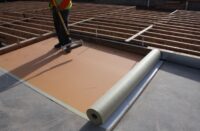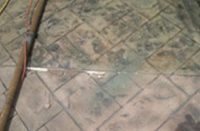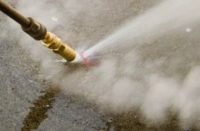 Keep your job looking beautiful to enhance both your reputation and your wallet.
Keep your job looking beautiful to enhance both your reputation and your wallet.
The growth of the decorativeconcrete industry in recent years has allowed contractors to challenge their creativity with a huge array of new designs, colors, textures and techniques. But after the job is done, maintaining that dazzling, just-completed look is often overlooked.
Cleaning and resealing an old job isn’t nearly as interesting as creating a new design, and it’s less profitable too.
However, industry experts say contractors are missing a great opportunity. Making sure decorative concrete looks fresh for years to come can bring a number of benefits — satisfied customers, repeat business and a new profit center, to name a few.
Clients appreciate a contractor who can not only work wonders with concrete, but can also help them keep their patio, deck or driveway looking impressive. New products are available to handle almost any maintenance situation, even ones that initially look impossible.
Routine maintenance is fairly straightforward. The No. 1 priority is to make sure the surface is clean and dry before it’s resealed. Most decorative surfaces can be cleaned with water and a mild cleaner.
Scott Balch, a ConcreteScience contractor in Dallas, uses pressure washing, extraction cleaning or both. “Acrylic sealers are more forgiving when it becomes time to reapply,” he says. “Most situations require only the cleaning of the surface and the application of the new acrylic sealer.”
Careful how you clean
Julio Hallack, a concrete restoration specialist based in Turlock, Calif., says many people use cleaning chemicals that are too powerful and eat away the concrete. Don’t use ammonia, he says. And Simple Green should be used only if it is diluted with 20 parts water.
“You want to use something really, really mild,” he says. “There’s no need to go in with a heavy-duty detergent.”
Through his business, Concrete Innovations by Hallack, he offers his clients simple rules for dealing with stained concrete floors: Dust mop daily and wash weekly with cold water and a mild, diluted citrus cleaner. “If people follow these simple recommendations they may need to reseal their floors in two to three years.”
The two- to three-year resealing schedule is also recommended for stamped and colored concrete. This depends, of course, on the kind of traffic and wear it’s exposed to. “If you wait longer, you may notice the color fade slightly,” he says. “But just like waxing a car, reseal your stamped concrete and the color will be as vibrant as the day it was installed.”
Light commercial floors may need resealing every six months, Hallack says. Heavy-duty commercial floors, in supermarkets for example, are stripped, buffed and resealed weekly with water-based products.
Cleaning is the first and most important step to any concrete maintenance program, but the next step — making sure the concrete is dry — takes patience.
“Contractors are guilty of rushing in and trying to put sealers on before the floors are dry. They trap moisture and it’s a big mistake,” Hallack says. “Floors need to be dry 100 percent.” Hallack recently let a floor dry for two complete days, then tested for moisture before resealing.
Dealing with problem areas
When contractors face mildew stains, sun damage, or just particularly stubborn dirt, they may need to dig deeper into their bag of tricks to come up with a solution.
Contractors can choose from a range of products and techniques for cleaning and maintaining problem areas on decorative concrete, says Scott Buscher, marketing director for Prosoco Inc., a custom formulator of specialty cleaners and protective treatments for masonry and concrete.
Balch uses a more aggressive cleaner and a hand-held nylon brush for small areas. For large areas, he uses low-speed buffers with scrubbing pads. “Stains normally just require more elbow grease,” he says.
Chemist Mark Granados of Surtec Inc., which manufactures sealers, cleaners and specialty maintenance products in Tracy, Calif., recommends inspecting for water damage. Materials such as leaves or firewood left on a patio for a long time can trap moisture underneath. You must fix moisture problems before applying new sealer. 
Beware of the sun
Contractors say sunlight is another big enemy of acrylic sealers. Sometimes customers will complain that the sun has faded half of their patio. Dirt and mildew can also damage one part of the project, while the other side looks great.
“If your sealer has yellowed, not a whole lot can be done to restore that,” Granados says. If mold and mildew have intruded, the cause of the moisture problem must be fixed. “Your sealer is only as good as your foundation.”
Balch says he would first give the patio a thorough cleaning and then try to reseal using more or less sealer on different parts of the patio. “If an even look cannot be achieved, the process becomes more complicated,” he says. “It becomes necessary to remove all or a portion of the old sealer prior to application of the new sealer.”
Buscher says you can revive faded concrete by acid-staining or applying a protective treatment that enhances its appearance. “When just a portion of the surface needs work, though, it’s usually best to clean, stain or protect the entire surface to ensure uniformity of appearance,” he says.
“Surfaces that are beyond redemption usually got that way because of neglect or errors in installation. In these rare cases, replacement is the answer, with an eye toward not making the same mistakes a second time.”
When to strip
How many times can you apply a sealer to the surface before it requires a complete stripping?
There’s no magic number, but when the buildup of sealers starts to discolor or distract from the original look, it’s time to strip, says Steven W. Hicks, president and CEO of ConcreteScience International Inc.
Some water-repellants penetrate into the pores of the concrete and form a barrier against water intrusion that may last as long as five years. A film-forming sealer on top of that is “the best of all worlds, as long as you aren’t trapping escaping moisture,” Hicks says.
You can apply sealers many times to properly maintained surfaces, Granados says, and that means keeping them clean. He recommends frequent sweeping and cleaning of interior concrete to minimize dirt and grit. “That doesn’t sell many chemicals, but we like to recommend walk-off mats in entryways because even a high-performance sealer can be scratched.”
Control joints deserve special attention
Keeping control joints free of water and debris will also lengthen the life of any decorative concrete project. If water seeps through the joints and into the substrate, the concrete will deteriorate. Dirt and debris in the joints can cause damage to the joint nosings as the concrete moves, Balch says.
If the job will see only foot traffic, contractors prefer a polyurethane sealant. This sealant type can flex as the concrete moves and also comes in various colors. On driveways, most prefer flexible epoxy sealants because they can stand up to vehicular traffic, keeping the joint shoulders intact.
3M offers new urethane adhesives and sealants to repair cracks and spalls in as little as 15 minutes. The company says its urethane sealants are flexible enough to compensate for expansion and contraction around a joint. The products can also fix spalls, often found at concrete joints in heavy traffic areas.
|
|
Giant “bathtub ring” responds to solution
Two weeks before the new Bronco Stadium opened in Denver, ConcreteScience was called in to quickly solve a problem that 15 companies hadn’t been able to fix.
Instead of concrete risers, the stadium used metal risers so fans could stomp their feet and create the pounding noise known as “Rocky Mountain Thunder.” However, rain on the metal risers created rust. This ran down the concrete walls and stained them, making the stadium look like it had a giant bathtub ring.
ConcreteScience chemists in Kansas City received a sample. They created four possible solutions, and one worked. Scrubbing the walls by hand was a mammoth project. However, once the crew vacuumed up the solution and treated the walls with water repellant, it looked good as new.
“We have stain removers for just about anything,” says Hicks, who recently partnered with Prosoco Inc., which markets ConcreteScience products. “I think almost any stain can be removed if people are willing to take the time and figure it out.”
Keep in touch with customers, experts
Hicks believes contractors should pay more attention to maintaining their work. He says contractors can be even more successful if they organize their business to make maintenance a higher priority. It’s good fill-in work when times are slow, it targets existing customers and it can be high-margin work, he says.
A few easy marketing techniques could go a long way. Good business owners send out a maintenance reminder postcard one year after the completed job. Others pick up the phone and see how their work is holding up.
“If you don’t call them, they will not call you,” Hicks says.
Hallack says contractors shouldn’t be afraid to learn from each other and to network with good companies. Scofield and Miracote experts, for example, are extremely knowledgeable and love what they do, he says. Even though contractors may compete for the same customers, the industry as a whole will benefit from more collaboration.
“I love to share what I know,” he says. “I hate to see the contractors go through the nightmares I went through. We all should commit to sharing information.”
















